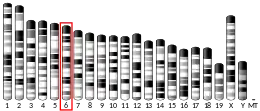SPAM1
Hyaluronidase PH-20 is an enzyme that in humans is encoded by the SPAM1 gene.[5][6][7]
| SPAM1 | |||||||||||||||||||||||||||||||||||||||||||||||||||
|---|---|---|---|---|---|---|---|---|---|---|---|---|---|---|---|---|---|---|---|---|---|---|---|---|---|---|---|---|---|---|---|---|---|---|---|---|---|---|---|---|---|---|---|---|---|---|---|---|---|---|---|
| Identifiers | |||||||||||||||||||||||||||||||||||||||||||||||||||
| Aliases | SPAM1, HEL-S-96n, HYA1, HYAL1, HYAL3, HYAL5, PH-20, PH20, SPAG15, sperm adhesion molecule 1 | ||||||||||||||||||||||||||||||||||||||||||||||||||
| External IDs | OMIM: 600930 MGI: 1921718 HomoloGene: 50610 GeneCards: SPAM1 | ||||||||||||||||||||||||||||||||||||||||||||||||||
| |||||||||||||||||||||||||||||||||||||||||||||||||||
| |||||||||||||||||||||||||||||||||||||||||||||||||||
| |||||||||||||||||||||||||||||||||||||||||||||||||||
| |||||||||||||||||||||||||||||||||||||||||||||||||||
| |||||||||||||||||||||||||||||||||||||||||||||||||||
| Wikidata | |||||||||||||||||||||||||||||||||||||||||||||||||||
| |||||||||||||||||||||||||||||||||||||||||||||||||||
Hyaluronidase degrades hyaluronic acid, a major structural proteoglycan found in extracellular matrices and basement membranes. Six members of the hyaluronidase family are clustered into two tightly linked groups on chromosome 3p21.3 and 7q31.3. This gene was previously referred to as HYAL1 and HYA1 and has since been assigned the official symbol SPAM1; another family member on chromosome 3p21.3 has been assigned HYAL1. This gene encodes a GPI-anchored enzyme located on the human sperm surface and inner acrosomal membrane. This multifunctional protein is a hyaluronidase that enables sperm to penetrate through the hyaluronic acid-rich cumulus cell layer surrounding the oocyte, a receptor that plays a role in hyaluronic acid induced cell signaling, and a receptor that is involved in sperm-zona pellucida adhesion. Abnormal expression of this gene in tumors has implicated this protein in degradation of basement membranes leading to tumor invasion and metastasis. Multiple protein isoforms are encoded by transcript variants of this gene.[7]
References
- GRCh38: Ensembl release 89: ENSG00000106304 - Ensembl, May 2017
- GRCm38: Ensembl release 89: ENSMUSG00000029678 - Ensembl, May 2017
- "Human PubMed Reference:". National Center for Biotechnology Information, U.S. National Library of Medicine.
- "Mouse PubMed Reference:". National Center for Biotechnology Information, U.S. National Library of Medicine.
- Gmachl M, Sagan S, Ketter S, Kreil G (Feb 1994). "The human sperm protein PH-20 has hyaluronidase activity". FEBS Lett. 336 (3): 545–8. doi:10.1016/0014-5793(93)80873-S. PMID 8282124. S2CID 46082782.
- Jones MH, Davey PM, Aplin H, Affara NA (Mar 1996). "Expression analysis, genomic structure, and mapping to 7q31 of the human sperm adhesion molecule gene SPAM1". Genomics. 29 (3): 796–800. doi:10.1006/geno.1995.9931. PMID 8575780.
- "Entrez Gene: SPAM1 sperm adhesion molecule 1 (PH-20 hyaluronidase, zona pellucida binding)".
Further reading
- Jansen S, Ekhlasi-Hundrieser M, Töpfer-Petersen E (2001). "Sperm adhesion molecules: structure and function". Cells Tissues Organs (Print). 168 (1–2): 82–92. doi:10.1159/000016809. PMID 11114590. S2CID 20490883.
- Csoka AB, Frost GI, Stern R (2002). "The six hyaluronidase-like genes in the human and mouse genomes". Matrix Biol. 20 (8): 499–508. doi:10.1016/S0945-053X(01)00172-X. PMID 11731267.
- Cherr GN, Yudin AI, Overstreet JW (2002). "The dual functions of GPI-anchored PH-20: hyaluronidase and intracellular signaling". Matrix Biol. 20 (8): 515–25. doi:10.1016/S0945-053X(01)00171-8. PMID 11731269.
- Lathrop WF, Carmichael EP, Myles DG, Primakoff P (1991). "cDNA cloning reveals the molecular structure of a sperm surface protein, PH-20, involved in sperm-egg adhesion and the wide distribution of its gene among mammals". J. Cell Biol. 111 (6 Pt 2): 2939–49. doi:10.1083/jcb.111.6.2939. PMC 2116349. PMID 2269661.
- Lin Y, Mahan K, Lathrop WF, et al. (1994). "A hyaluronidase activity of the sperm plasma membrane protein PH-20 enables sperm to penetrate the cumulus cell layer surrounding the egg". J. Cell Biol. 125 (5): 1157–63. doi:10.1083/jcb.125.5.1157. PMC 2120058. PMID 8195297.
- Lin Y, Kimmel LH, Myles DG, Primakoff P (1993). "Molecular cloning of the human and monkey sperm surface protein PH-20". Proc. Natl. Acad. Sci. U.S.A. 90 (21): 10071–5. Bibcode:1993PNAS...9010071L. doi:10.1073/pnas.90.21.10071. PMC 47715. PMID 8234258.
- Csóka AB, Scherer SW, Stern R (1999). "Expression analysis of six paralogous human hyaluronidase genes clustered on chromosomes 3p21 and 7q31". Genomics. 60 (3): 356–61. doi:10.1006/geno.1999.5876. PMID 10493834.
- Strausberg RL, Feingold EA, Grouse LH, et al. (2003). "Generation and initial analysis of more than 15,000 full-length human and mouse cDNA sequences". Proc. Natl. Acad. Sci. U.S.A. 99 (26): 16899–903. Bibcode:2002PNAS...9916899M. doi:10.1073/pnas.242603899. PMC 139241. PMID 12477932.
- Scherer SW, Cheung J, MacDonald JR, et al. (2003). "Human chromosome 7: DNA sequence and biology". Science. 300 (5620): 767–72. Bibcode:2003Sci...300..767S. doi:10.1126/science.1083423. PMC 2882961. PMID 12690205.
- Hillier LW, Fulton RS, Fulton LA, et al. (2003). "The DNA sequence of human chromosome 7". Nature. 424 (6945): 157–64. Bibcode:2003Natur.424..157H. doi:10.1038/nature01782. PMID 12853948.
- Evans EA, Zhang H, Martin-DeLeon PA (2004). "SPAM1 (PH-20) protein and mRNA expression in the epididymides of humans and macaques: utilizing laser microdissection/RT-PCR". Reprod. Biol. Endocrinol. 1 (1): 54. doi:10.1186/1477-7827-1-54. PMC 184449. PMID 12932297.
- Dunn CA, Mager DL (2006). "Transcription of the human and rodent SPAM1 / PH-20 genes initiates within an ancient endogenous retrovirus". BMC Genomics. 6: 47. doi:10.1186/1471-2164-6-47. PMC 1079825. PMID 15804358.




